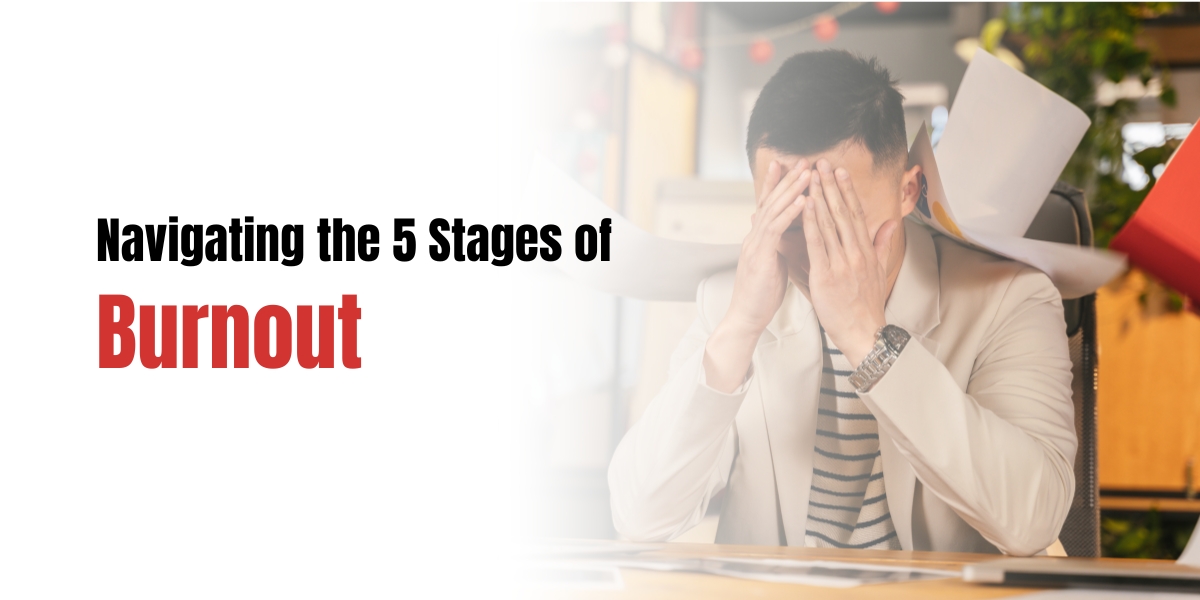
Navigating the 5 Stages of Burnout
Burnout is becoming a more serious issue for people in all sectors of the economy in today's stressful work environment. The demands of juggling work-life obligations, managing growing workloads, and meeting deadlines can cause persistent stress and tiredness, which can eventually lead to burnout.
When you are subjected to continuous or chronic interpersonal and emotional stressors without any rest, burnout develops. In the end, these encounters lead to weariness, scepticism, and decreased output. Burnout can negatively impact your mental, physical, and overall health and well-being.
Therefore, it's important to be able to recognize it early on and take action before it worsens and becomes a chronic problem.
5 Stages of Burnout
The following are the 5 stages of Burnout:Stage 1: The Honeymoon Phase
The honeymoon phase may turn out to be the most important phase in terms of transition before the heavier stages of burnout. During this stage, most of the employees tend to be over-committed to their jobs, volunteering for more responsibilities and love for their jobs. The honeymoon stage starts the cycle.
Navigating the Honeymoon Phase: It is here that work habits developed now can be a good defence for the potential risk of burnout. The top three things to avoid falling into include: not overcommitting, avoiding setting unrealistic goals, and maintaining a balance between work and personal life. Creating personal boundaries, recharging oneself on a regular basis, and mindfulness practices may well be fertile ground for harbouring energy and enthusiasm for the long haul.
Stage 2: Onset of Stress
The honeymoon phase eventually fades, and you start to feel stressed. While stress does not consume every moment of your day, it does tend to do so more often. When this phase begins, pay attention to any physical or psychological symptoms.
Navigating the Onset of Stress Phase: When this phase starts, pay attention to any physical or psychological symptoms. You can begin to become less productive when finishing activities or lose attention more readily. Physically, exhaustion may begin to set in, making it harder to fall asleep or enjoy leisure activities.
Stage 3: Chronic Stress
There will come a time when the tension becomes chronic or more enduring. Stress is going to impact your work as the strain increases inevitably. Apathy, not finishing things on time, arriving late to work, and procrastinating are a few examples.
Navigating the Chronic Stress Phase: Stress is going to impact your work as the strain increases inevitably. It involves maintaining your physical and emotional well-being, establishing limits, and knowing when to ask for assistance or take a break to refuel. Reacting to burnout is a necessary step toward self-care and well-being, not a selfish one.
Stage 4: Burnout
You are formally burned out, and you might start to feel more and more indifferent. As a result of ignoring the previous phases of stress and burnout, you've now attained an important weariness that can be debilitating. You can constantly fight with feelings of inadequacy, failure, and ineptitude.
Navigating the Burnout Phase: The first step in preventing burnout is identifying its early indicators in both yourself and your team. This signals the development of a mindfulness routine in which you assess your own mental and emotional well-being on a regular basis.
Stage 5: Habitual Burnout
Burnout can gradually become a part of your daily life and result in anxiety or sadness if it is not managed. Chronic physical and mental exhaustion may also set in, making it impossible for you to work. If you carry on in this manner, your position might be in danger.
Navigating the Habitual Burnout Phase: Comprehensive intervention, such as medical care, therapy, and significant lifestyle adjustments, is necessary to address chronic burnout. Reassessing professional decisions, creating new life objectives, and embracing a holistic approach to well-being are all possible steps in a long-term healing process. During this phase, professional, familial, and friend support is essential.
Conclusion
Burnout is a severe problem that can affect people and organizations in significant ways. People may control their stress and stop burnout from getting worse by being aware of the five stages of burnout. By participating in the Resiliency Program, we may establish surroundings that promote long-term success and health.